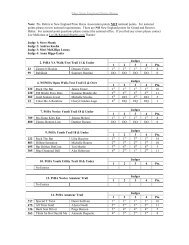2011 Official Rule Book - New England Pinto Horse Association
2011 Official Rule Book - New England Pinto Horse Association
2011 Official Rule Book - New England Pinto Horse Association
Create successful ePaper yourself
Turn your PDF publications into a flip-book with our unique Google optimized e-Paper software.
ClassEs<br />
C. Basic position<br />
1. The eyes should be up and shoulders back.<br />
2. Toes should be at an angle best suited to exhibitor’s<br />
conformation; ankle flexed in, heels down, calf of leg in<br />
contact with <strong>Pinto</strong> and slightly behind girth.<br />
3. Iron may be either on toe, ball of foot or “home”.<br />
D. Position in Motion<br />
1. At the walk and slow trot, body should be vertical<br />
2. Posting trot, body inclined forward<br />
3. Canter, body is half way between the posting trot and the<br />
walk<br />
4. Galloping and jumping, body is at the same inclination as<br />
the posting trot.<br />
E. Mounting and Dismounting<br />
1. To mount, take up reins in left hand and place hand on<br />
withers. Grasp stirrup leather with right hand and insert left<br />
foot in stirrup and mount.<br />
2. To dismount, exhibitor may either step down or slide down.<br />
The size of exhibitor must be taken into consideration.<br />
F. Class Routine<br />
1. Exhibitors shall enter ring, and shall proceed around ring<br />
at each gait, when a pattern is not worked first (flat or over<br />
fences).<br />
2. On command, reverse and repeat.<br />
The order to reverse may be executed by turning either<br />
toward or away from the rail.<br />
3. Exhibitors may be asked to work collectively without irons.<br />
4. Light contact with <strong>Pinto</strong>’s mouth is required.<br />
5. When class is Over Fences, the performance begins when<br />
the <strong>Pinto</strong> enters the ring or is given the signal to proceed<br />
after entering the ring.<br />
6. Except for refusals, jumping faults of the <strong>Pinto</strong> are not to<br />
be considered unless it is the result of the exhibitors ability.<br />
a. A refusal, loss of stirrup or trotting while on course<br />
when not part of a test constitute major faults and may<br />
be cause for elimination.<br />
b. Each exhibitor may circle once if desired before<br />
approaching first jump.<br />
c. He/she shall then proceed around course, keeping an<br />
even pace throughout.<br />
d. Three cumulative refusals will eliminate.<br />
e. If a refusal occurs in a double or triple, exhibitor shall<br />
re-jump all elements of the combination.<br />
G. Additional Work<br />
1. Exhibitors will perform not only the ring routine demanded<br />
of them, but also should be able to perform whatever<br />
additional tests from those listed below the judge may<br />
deem advisable to ask of them.<br />
2. All tests must be performed on the flat.<br />
3. Tests may be performed either collectively or individually,<br />
but no other test may be used.<br />
a. Back.<br />
b. Hand gallop and halt.<br />
c. Figure eight at canter on correct lead, demonstrating<br />
simple change of lead. (This is a change whereby<br />
the <strong>Pinto</strong> is brought back into a walk or trot and<br />
restarted into a canter on the opposite lead.) Figures<br />
to be commenced in center of two circles so that one<br />
change of lead is shown.<br />
d. Disengage feet from irons. Ride without irons for a<br />
brief period of time. No more than one minute at the<br />
trotting pace. Engage feet in irons.<br />
e. Dismount and mount.<br />
196 <strong>2011</strong> PtHA <strong>Rule</strong> <strong>Book</strong>



